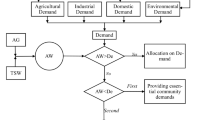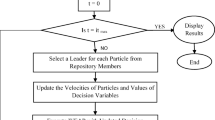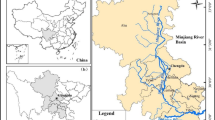Abstract
The problem of inter-sectoral water allocation is investigated for the utilizable water in the Cauvery river basin in the state of Karnataka, India. This paper aims to maximize the total benefit of available and utilizable water while trying to ensure a certain basic water right for every individual. It also aims to meet irrigation requirements as put forward by government (central or state) in drought contingency plan. In this context, a novel nonlinear optimization model is developed which utilizes hydro-agro-economic data collected from multiple sources. This optimization model allocates the available water among different competing sectors which includes municipality, industries and agriculture. Furthermore, the sensitivity analysis evaluates the economic impact of different parameters of competing demands such as water availability, population and basic water right (quantity). The results of this study reveal that the basic water right for essential needs can be ensured with integrated management of available surface water resources. This novel optimization model and policy analysis can be readily applied to other river basins across the globe.






Similar content being viewed by others
Notes
Center water Commission (CWC) comes under Ministry of Water Resource, Government of India.
Computed on the basis of the data available related to MSP, cost of cultivation, and yield for the year of 2010–11.
174 lpcd is per capita water demand as per BWSSB in the report.
Source: Projected Population of Karnataka 2012-2021, Directorate of Economics and Statistics, Bangalore, 2013, page 8, http://des.kar.nic.in/docs/Projected%20Population%202012-2021.pdf. Accessed on 17/6/2015.
The estimates are based on the flow measurements made by Central Water Commission at KM Vadi, Kudige, and MH Halli measurement points that are up-stream to KRS over the period from 1980 to 2011.
References
Abdul S (2008) Water poverty in urban India: a study of major cities. UGC-summer programme, UGC-Academic Staff College, Jamia Millia Islamia, New Delhi
Anon (Anonymous) (2011) 71-City water-excreta survey, 2005–06. Centre for Science and Environment, New Delhi
Babel MS, Gupta AD, Nayak DK (2005) A model for optimal allocation of water to competing demands. Water Resour Manag 19(6):693–712
Blanco-Gutirrez I, Varela-Ortega C, Purkey DR (2013) Integrated assessment of policy interventions for promoting sustainable irrigation in semi-arid environments: a hydro-economic modeling approach. J Environ Manag 128:144–160
Booker JF (1995) Hydrologic and economic impacts of drought under alternative policy responses. Water Resour Bull 31(5):889907
Booker JF, Young RA (1994) Modeling intrastate and interstate markets for Colorado River water resources. J Environ Econ Manag 26:66–87
BWSSB (2013) Bangalore water supply & sewerage board, Bangalore notification-I the Bangalore water supply (amendment) regulations, 2012
BWSSB (2015). http://www.bwssb.org/sites/default/files/bwssb-new-tariff.pdf. Accessed 25 Dec 2014
Chandrakanth MG (2009) Karnataka state water sector reform: current status, emerging issues and needed strategies. IWMI-Tata Water Policy Program, International Water Management Institute (IWMI)
COIN-OR (2015). https://projects.coin-or.org/Ipopt. Accessed 8 June 2015
CONTIN (2015) Contingency plan given by department of agriculture and cooperation ministry of agriculture, Government of India. http://agricoop.nic.in/acp.html. Accessed 25 Dec 2015
Debnath D, Boyer T, Stoecker A, Sanders L (2015) Nonlinear reservoir optimization model with stochastic inflows: case study of lake tenkiller. J Water Resour Plan Manag 141(1):04014046
Diaz GE, Brown TC, Sveinsson OG (2000) Aquaris: a modeling system for river basin water allocation. Tech. rep., General Technical Report RM-GTR-299, US Department of Agriculture, Fort Collins, Colorado
Divakar L, Babel MS, Perret SR, Gupta AD (2011) Optimal allocation of bulk water supplies to competing use sectors based on economic criterion—an application to the chao phraya river basin, thailand. J Hydrol 401(1–2):22–35
GOI (2013a) The National Food Security Act. The Gazette of India, Government of India. September, 2013
GOI (2013b) Annual report 2013. Center Water Comission, Ministry of Water Resource, Government of India
GOI (2013c) Ground water year book, 2013. Ministry of Water Resource, Government of India, India
GOI (2015a) Contingency plan published by Department of Agriculture and Cooperation. Ministry of Agriculture, Govt of India (2014). http://agricoop.nic.in/agriculture-contingency-plan-listing. Accessed 24 Apr 2017
GOI (2015b) Government of India. http://www.mdws.gov.in/NRDWP. Accessed 28 May 2015
GOI (2015c) Government of India. http://www.censusindia.gov.in. Accessed 28 May 2015
Graveline N, Majone B, Van Duinen R, Ansink E (2014) Hydro-economic modeling of water scarcity under global change: an application to the g´allego river basin (spain). Reg Environ Change 14(1):119–132. doi:10.1007/s10113-013-0472-0
Griffin RC (2006) Water resource economics: the analysis of scarcity, policies, and projects. MIT Press, Cambridge
Jain SK, Agarwal PK, Singh VP (2007) Hydrology and water resources of India, water science and technology library, vol 57. Springer, Netherlands
Juan R, Jose R, Miguel A, Rafael L, Emilio C (2001a) Optimisation model for water allocation in deficit irrigation systems i. Description of the model. Agric Water Manag 48:103–116
Juan R, Jose R, Miguel A, Rafael L, Emilio C (2001b) Optimisation model for water allocation in deficit irrigation systems ii. Application to the bembezar irrigation system. Agric Water Manag 48:117–132
Julien JH, Manuel PV, David ER, Josue MA, Rld Jay, Richard EH (2009) Hydro-economic models: concepts, design, applications, and future prospects. J Hydrol 375:627–643
Kirby M, Mainuddin M, Gao L, Connor J, Ahmad M (2012) Integrated, dynamic economic-hydrology model for the murray-darling basin. In: Fifty-sixth annual conference, Australian Agricultural & Resource Economics Society, Fremantle
Kragt ME, Newham LTH, Bennett J, Jakeman AJ (2011) An integrated approach to linking economic valuation and catchment modelling. Environ Model Softw 26(1):92–102
Letcher R, Croke B, Merritt W, Jakeman A (2006) An integrated modelling toolbox for water resources assessment and management in highland catchments: sensitivity analysis and testing. Agric Syst 89(1):132–164
McKinney DC, Ximing C, Rosegrant MW, Claudia R, Christopher AS (1999) Modeling water resources management at the basin level: review and future directions. In: International Water Management Institute (IWMI). Colombo, Sri Lanka, p 59
McKinney DC, Ximing C, Leon SL (1999) Integrated water resources management model for the Syr Darya Basin. Central Asia Mission, US Agency for International Development
Natasha M (1996) Water and land in South Africa: economy wide impacts of reform a case study for the Olifants river. TMD discussion papers 12, International Food Policy Research Institute (IFPRI)
Noel JE, Howitt RE (1982) Conjunctive multibasin management: an optimal control approach. Water Resour Res 18(4):753–763
NWP (2012) National water policy. Ministry of Water Resources, Govt of India, New Delhi
Peter H, Gleick M, IWRA (1996) Basic water requirements for human activities: meeting basic needs. Water Int 21:83–92
Ringler C (2001) Optimal water allocation in the Mekong river basin. ZEF-Discussion Papers on Development Policy No 38, Center for Development Research, University of Bonn, Bonn, Germany, p 50
Rosegrant MW, Ringler C, Mckinney DC, Cai X, Keller A, Donoso G (2000) Integrated economic hydrologic water modeling at the basin scale: the maipo river basin. Agriculture 24:33–46
The Hindu (2015) A daily newspaper. http://www.thehindu.com/news/cities/bangalore/private-water-suppliers-hit-pay-dirt\-as-water-crisis-worsens/article2984302.ece Accessed 25 Dec 2014
Tilmant A, Kelman R (2007) A stochastic approach to analyze trade-offs and risks associated with large-scale water resources systems. Water Resour Res 43:W06425. doi:10.1029/2006WR005094
Tilmant A, Pinte D, Goor Q (2008) Assessing marginal water values in multipurpose multireservoir systems via stochastic programming. Water Resour Res 44(12):1–17
UNICEF (2004). http://www.unicef.org/sowc04/. Accessed 25 Dec 2015
Vedula S, Nagesh Kumar D (1996) An integrated model for optimal reservoir operation for irrigation of multiple crops. Water Resour Res 32(4):1101–1108
Ximing C, Mark WR, Claudia R (2003) Physical and economic efficiency of water use in the river basin: Implications for efficient water management. Water Resour Res 39:1013. doi:10.1029/2001WR000748
Author information
Authors and Affiliations
Corresponding author
Rights and permissions
About this article
Cite this article
Patel, S.S., Ramachandran, P. An optimization model and policy analysis of water allocation for a river basin. Sustain. Water Resour. Manag. 4, 433–446 (2018). https://doi.org/10.1007/s40899-017-0124-5
Received:
Accepted:
Published:
Issue Date:
DOI: https://doi.org/10.1007/s40899-017-0124-5




